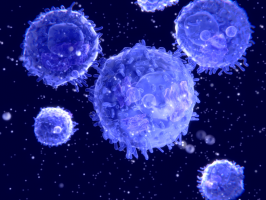
Bioengineers at the University of California San Diego have developed a control system that could make CAR T-cell therapy safer and more powerful when treating cancer.
By programming CAR T cells to switch on when exposed to blue light, the researchers controlled the cells to destroy skin tumours in mice without harming healthy tissue.
In tests in mice, administering the engineered CAR T cells and stimulating the skin tumour sites with blue LED light reduced tumour size by eight to ninefold.
The results were observed in nine out of ten mice tested.
Engineered CAR T cells on their own did not inhibit tumour growth.
The work is published in Science Advances.
Chimeric antigen receptor (CAR) T-cell therapy is a promising new approach to treat cancer.
It involves collecting a patient's T cells and genetically engineering them to express special receptors on their surface that can recognise an antigen on targeted cancer cells.
The engineered T cells are then infused back into the patient to find and attack cells that have the targeted antigen on their surface.
While this approach has worked well for some types of blood cancer and lymphoma, it so far has not worked well against solid tumours.
One reason is because many targeted cancer antigens are also expressed on healthy cells.
"It is very difficult to identify an ideal antigen for solid tumours with high specificity so that CAR T cells only target these diseased tumour sites without attacking normal organs and tissues," said Peter Yingxiao Wang, a professor of bioengineering at the UC San Diego Jacobs School of Engineering and the senior author of the study. "Thus, there is a great need to engineer CAR T cells that can be controlled with high precision in space and time."
To create such cells, Wang and his team installed an on-switch that would allow them to activate the CAR T cells at a specific site in the body. The switch uses two engineered proteins located inside the CAR T cell that bind when exposed to one-second pulses of blue light. Once bound together, the proteins trigger expression of the antigen-targeting receptor.
Since light cannot penetrate deeply in the body, Wang envisions that this approach could be used to treat solid tumours near the surface of the skin. For future studies, Wang is looking to collaborate with clinicians to test the approach on patients with melanoma.